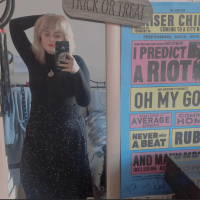Hi! I'm a third year history student who loves cats, music, tattoos and records! I'm passionate about disability and mental health advocacy and awareness :)

Top Tips for Sustainable and Second-Hand Clothes Shopping
Entering the world of slow and second-hand fashion can be daunting, especially with the availability, low-cost and accessibility of fast…
May 5, 2022,
read.
- Remember that buying fast fashion isn’t a sin…
Entering the world of slow and second-hand fashion can be daunting, especially with the availability, low-cost and accessibility of fast fashion that is so important as a student on a budget, so remember that you don’t have to be a perfect eco-warrior!
Teen Vogue explained that the slow and second-hand fashion movement often falls prey to eco-fascism: ‘While it’s true human consumption harms the environment, eco-fascists place the blame exclusively on the marginalized. Because consumerism produces massive amounts of garbage, eco-fascists incorrectly blame poor people (of colour) for using plastic bags and other cheap, disposable products — often without pointing to the damage done by major polluting corporations, like those in the fossil fuel industry.’
So, while it is important to be a more conscious shopper, please remember that it isn’t accessible for everyone and its okay to use fast fashion, even if you want to cut down on it! For me, the main point in trying to buy second hand was my personal desire to cut down on my own clothes that enter landfill, and to give clothes a second chance at life as I love sewing and DIYing outfits
2. Lose the stigma surrounding buying second-hand:
It’s very easy to internalise the idea that second hand shopping is gross and full of dead people’s clothes. While this CAN be true, this sort of stigma is making you miss out on some amazing finds so don’t knock it till you’ve tried it! (Just wash the clothes…)
Thankfully the recent explosion of interest into eco-friendly and sustainable fashion has helped this but I do still know people who turn their nose up at second hand, so why not give it a shot?
Be mindful of over-consumption:
The reduced volume of second-hand items available compared to fast fashion has made me more conscious of what I buy and how much, meaning that I’m more inclined to buy items that I will get a lot of wear out of rather than getting something that will sit in my wardrobe for years.
3. Get comfortable with DIYing and sewing!
Personally, I love being able to personalise clothes with my (terrible, very minimal) sewing ability to create custom pieces and adjust clothes to get more wear out of them and give them a longer life.
This isn’t essential to buying second-hand but I love visualising the potential of a new item, whether that’s by dying it or adjusting the fit. I don’t own a sewing machine so don’t worry about that if you aren’t a seamstress (like me!).
I think that putting time into an item- which normally involves putting patches or new closures onto something for me- makes me more conscious of what I’m buying so I don’t end up with mountains of clothes that I won’t wear.
4. Remember that charity shopping can be hit-or-miss:
Charity shops can be a goldmine, but they can also be completely useless when looking for new clothes so be prepared to shop around!
For Lincoln, I’ve found that regularly checking the charity shops on the high street (up to Steep Hill and down the bottom near campus) increases your chances of finding new items.
5. Mastering eBay, Vinted and Depop:
eBay, Vinted and Depop are the best places to find more specific second-hand items in my experience. Use a variety of keywords as sellers may not use the same descriptors as you when listing items. You are also able to search for branded or shop-specific items with greater ease. It takes time to become an eBay wizard, and I recommend using the ‘lowest price and postage’ filter to see some amazing good-quality bargains, as well as bidding on items or putting in offers as sites like Depop tend to be more expensive than eBay.
I love band t shirts but often have to use random keywords like gothic, punk, alternative etc to find what I like. Also, feel free to haggle within reason! The treasure hunt is part of the fun!
6. Facebook groups:
You can join Facebook groups specifically for buying and selling particular brands. For example, I’m in a Killstar group and a Disturbia group and have found some amazing discounted, discontinued items online that would be double the price on the official stores.
7. Kilo Sales and Vintage Fairs:
Vintage shops- such as Yak in the Strait- can be pretty expensive, so utilising vintage fairs and kilo sales are a great way to get more affordable vintage items.
The Engine Shed are hosting two vintage fairs in May:
Lincoln’s Vintage Kilo Sale 8th May 2022 10am
Lou Lou’s Vintage Fair 15th May 2022
I’ve been to past versions of these events and they’re great!
- Topics
- Charity shopping
- Fashion




